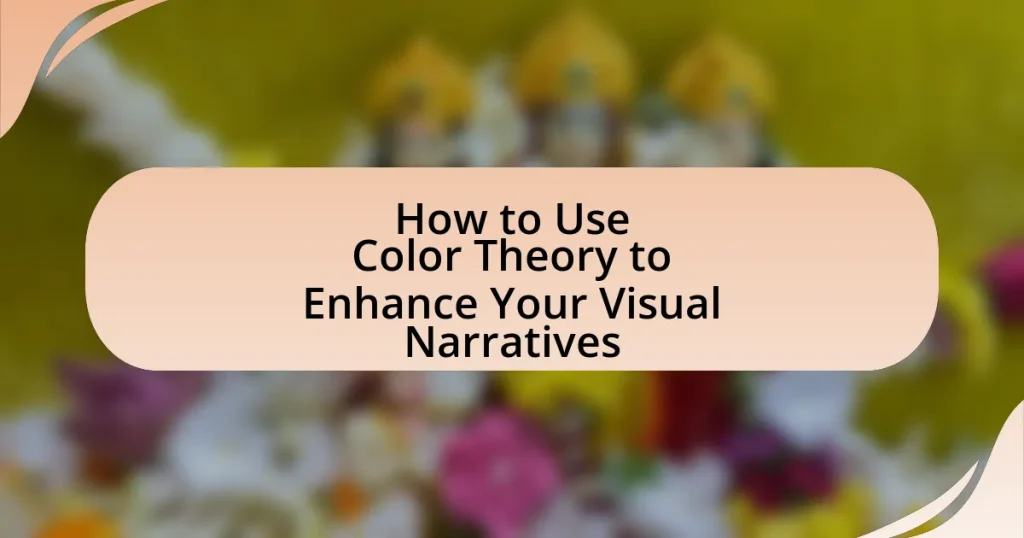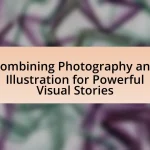Color theory is a crucial framework that explains the interaction and emotional impact of colors in visual narratives. This article explores the significance of color theory in storytelling, detailing its fundamental principles such as the color wheel, color harmony, and the psychological effects of color. It examines how color choices influence viewer perception, emotional responses, and character development, while also providing practical guidance on applying color theory effectively in visual projects. Additionally, the article highlights advanced techniques, common pitfalls, and best practices for maintaining consistency in color usage, ultimately enhancing the overall narrative experience.
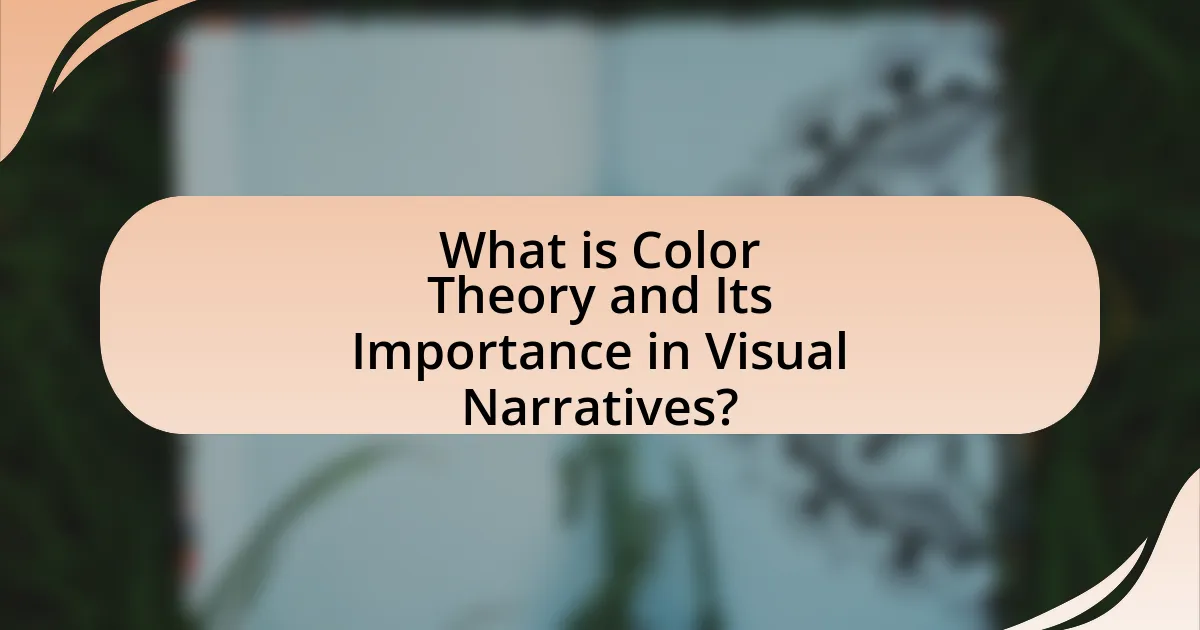
What is Color Theory and Its Importance in Visual Narratives?
Color theory is a framework that explains how colors interact, their relationships, and their effects on human perception and emotions. In visual narratives, color theory is crucial because it influences mood, guides viewer attention, and enhances storytelling by evoking specific feelings. For instance, warm colors like red and orange can create a sense of urgency or excitement, while cool colors like blue and green often evoke calmness or tranquility. Research indicates that color can affect cognitive processing and emotional responses, making it a powerful tool in visual communication. Understanding and applying color theory allows creators to effectively convey themes and emotions, thereby enriching the viewer’s experience and engagement with the narrative.
How does color theory influence storytelling in visual media?
Color theory significantly influences storytelling in visual media by establishing emotional connections and guiding audience perception. Different colors evoke specific feelings; for instance, red can signify passion or danger, while blue often conveys calmness or sadness. This emotional resonance helps to enhance narrative depth and character development. Research indicates that color choices can affect viewer engagement and interpretation, as seen in films like “The Sixth Sense,” where color palettes are strategically used to signify shifts in mood and plot. Thus, effective application of color theory in visual storytelling not only enriches the narrative but also shapes audience reactions and understanding.
What are the fundamental principles of color theory?
The fundamental principles of color theory include the color wheel, color harmony, and the psychological effects of color. The color wheel, developed by Isaac Newton, organizes colors into primary, secondary, and tertiary categories, providing a visual representation of relationships between colors. Color harmony refers to the aesthetically pleasing combinations of colors, such as complementary, analogous, and triadic schemes, which create balance and visual interest. The psychological effects of color influence emotions and perceptions; for example, blue often evokes calmness, while red can stimulate excitement. These principles are essential for effective visual narratives, as they guide the use of color to enhance storytelling and emotional impact.
How do colors evoke emotions and set the tone in narratives?
Colors evoke emotions and set the tone in narratives by influencing psychological responses and creating associations. For instance, warm colors like red and orange often evoke feelings of passion or urgency, while cool colors like blue and green can induce calmness or tranquility. Research indicates that color perception is linked to emotional responses; a study published in the journal “Color Research and Application” by Andrew Elliot and Markus Maier found that red can enhance feelings of excitement and energy, while blue can promote feelings of peace and serenity. This understanding of color psychology allows creators to strategically use colors to enhance the emotional impact and overall tone of their narratives.
What are the key components of color theory?
The key components of color theory are the color wheel, color harmony, and the context of color. The color wheel organizes colors into primary, secondary, and tertiary categories, illustrating their relationships. Color harmony refers to the aesthetically pleasing combinations of colors, which can evoke specific emotions and reactions. The context of color involves how colors interact with each other and their impact on perception, influenced by cultural and situational factors. These components are foundational in understanding how to effectively use color in visual narratives.
What is the color wheel and how is it used in design?
The color wheel is a circular diagram that represents the relationships between colors, typically organized into primary, secondary, and tertiary colors. In design, the color wheel is used to create harmonious color schemes, guide color selection, and enhance visual narratives by illustrating how colors interact, such as complementary, analogous, and triadic relationships. This systematic approach helps designers evoke specific emotions and convey messages effectively, as evidenced by studies showing that color choices can significantly influence viewer perception and engagement.
What are primary, secondary, and tertiary colors?
Primary colors are red, blue, and yellow; these colors cannot be created by mixing other colors. Secondary colors are green, orange, and purple, formed by mixing two primary colors: green from blue and yellow, orange from red and yellow, and purple from red and blue. Tertiary colors are created by mixing a primary color with a secondary color, resulting in colors like red-orange, yellow-green, and blue-purple. This classification is foundational in color theory, which is essential for enhancing visual narratives.
How can understanding color harmony enhance visual narratives?
Understanding color harmony enhances visual narratives by creating a cohesive and emotionally resonant experience for the audience. When colors are harmoniously combined, they evoke specific feelings and guide viewers’ perceptions, making the narrative more engaging. Research indicates that color combinations can influence emotional responses; for instance, complementary colors can create tension, while analogous colors promote tranquility. This strategic use of color not only supports the story’s mood but also aids in visual storytelling by emphasizing key elements and guiding the viewer’s focus, ultimately enriching the overall narrative experience.
What are the different types of color harmonies?
The different types of color harmonies include complementary, analogous, triadic, split-complementary, tetradic, and monochromatic. Complementary color harmony involves colors opposite each other on the color wheel, creating high contrast and vibrant visuals. Analogous harmony consists of colors next to each other on the wheel, providing a serene and comfortable design. Triadic harmony uses three evenly spaced colors on the wheel, offering a balanced yet colorful palette. Split-complementary harmony combines one base color with two adjacent to its complementary color, allowing for contrast without the tension of direct complements. Tetradic harmony involves two complementary color pairs, creating a rich and diverse color scheme. Lastly, monochromatic harmony utilizes variations in lightness and saturation of a single color, resulting in a cohesive and unified look. Each type of color harmony serves distinct purposes in visual narratives, enhancing emotional impact and aesthetic appeal.
How does color contrast affect visual storytelling?
Color contrast significantly enhances visual storytelling by guiding viewer attention and conveying emotional tone. High contrast between colors can create focal points, making key elements stand out, while low contrast can evoke a sense of harmony or subtlety. For instance, in film, directors often use contrasting colors to signify conflict or tension, as seen in the use of red and green in “The Godfather,” which emphasizes the duality of characters and themes. Research indicates that color contrast influences perception and emotional response, with studies showing that contrasting colors can increase viewer engagement and retention of information.
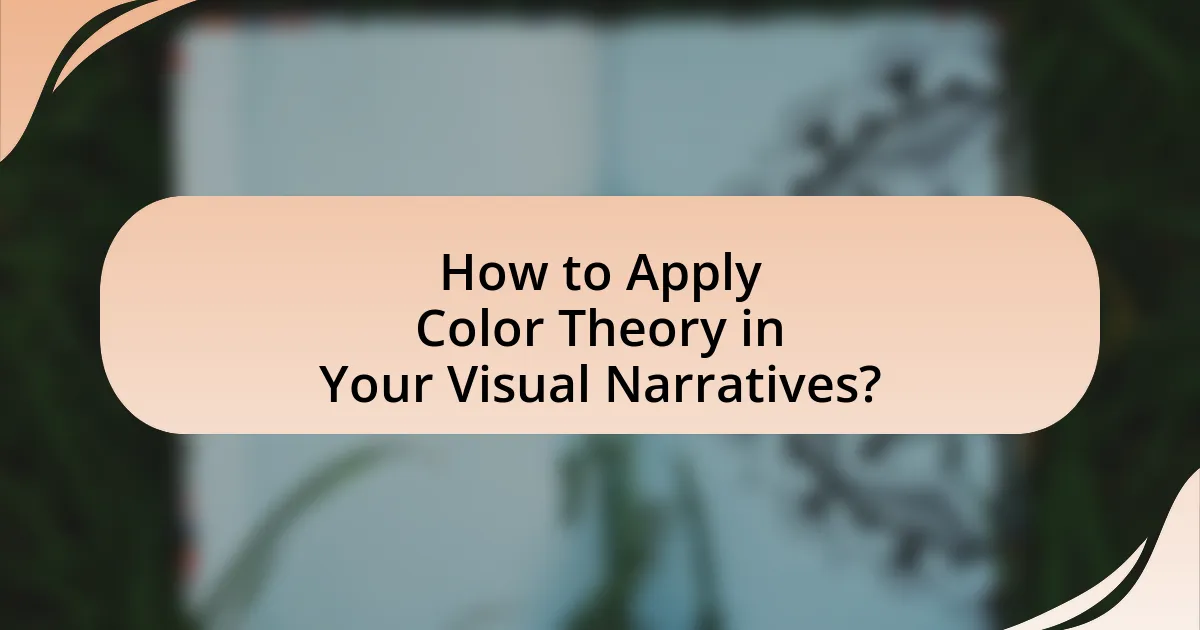
How to Apply Color Theory in Your Visual Narratives?
To apply color theory in your visual narratives, utilize the color wheel to select harmonious color schemes that evoke specific emotions and enhance storytelling. For instance, complementary colors create contrast and draw attention, while analogous colors provide a sense of harmony and cohesion. Research indicates that colors can influence viewer perception; for example, blue often conveys calmness, while red can evoke excitement or urgency. By strategically choosing colors based on their psychological effects, you can effectively guide the audience’s emotional response and reinforce the narrative’s themes.
What steps can you take to incorporate color theory into your projects?
To incorporate color theory into your projects, start by understanding the color wheel and the relationships between colors, such as complementary, analogous, and triadic schemes. This foundational knowledge allows you to select color combinations that evoke specific emotions and enhance visual storytelling. For instance, using complementary colors can create contrast and draw attention, while analogous colors can provide harmony and cohesion. Research indicates that color choices can significantly impact viewer perception and emotional response, as demonstrated in studies like “The Impact of Color on Marketing” by Satyendra Singh, which found that color increases brand recognition by up to 80%. By applying these principles, you can effectively enhance the visual narratives in your projects.
How do you choose a color palette for your narrative?
To choose a color palette for your narrative, first identify the emotions and themes you want to convey. This foundational step ensures that the colors selected resonate with the intended message. For instance, warm colors like red and orange evoke feelings of passion and energy, while cool colors like blue and green can create a sense of calm or sadness. Research in color psychology supports these associations, indicating that colors can significantly influence perception and emotional response. By aligning your color choices with the narrative’s emotional tone, you enhance the overall impact and coherence of your visual storytelling.
What tools can assist in selecting effective color combinations?
Tools that can assist in selecting effective color combinations include Adobe Color, Coolors, and Paletton. Adobe Color allows users to create color schemes based on color theory principles, offering options like complementary and analogous colors. Coolors provides a user-friendly interface for generating color palettes quickly, enabling users to explore various combinations and save their favorites. Paletton is designed for web designers, allowing for the creation of color schemes that work well together in digital formats. These tools are widely used in design and art, demonstrating their effectiveness in helping users choose harmonious color combinations.
How can color theory enhance character development and setting?
Color theory enhances character development and setting by using specific colors to evoke emotions and convey personality traits. For instance, warm colors like red and orange can signify passion or aggression, while cool colors like blue and green often represent calmness or tranquility. This application of color can help audiences quickly understand a character’s emotional state or the mood of a setting. Research in psychology indicates that colors can influence perception and behavior; for example, a study published in the journal “Color Research and Application” found that colors can significantly affect mood and decision-making. By strategically employing color theory, creators can deepen the audience’s connection to characters and settings, making narratives more engaging and impactful.
What colors are associated with specific character traits?
Colors are associated with specific character traits as follows: Red signifies passion and aggression, often linked to strong emotions and leadership. Blue represents calmness and trustworthiness, commonly associated with reliability and stability. Yellow embodies optimism and creativity, frequently connected to cheerfulness and innovation. Green symbolizes growth and harmony, typically associated with balance and renewal. Black conveys power and sophistication, often linked to elegance and authority. White represents purity and simplicity, commonly associated with innocence and clarity. These associations are rooted in psychological studies and cultural interpretations, demonstrating how colors can influence perceptions of character traits in visual narratives.
How can color choices reflect the mood of a setting?
Color choices can significantly reflect the mood of a setting by evoking specific emotional responses. For instance, warm colors like red and orange can create feelings of warmth, excitement, or aggression, while cool colors such as blue and green often evoke calmness, tranquility, or sadness. Research in color psychology supports this, indicating that colors can influence human emotions and perceptions; for example, a study published in the journal “Color Research and Application” found that red can increase heart rates and feelings of arousal, while blue can lower anxiety levels. Thus, the strategic use of color in visual narratives can effectively enhance the emotional impact of a setting.
What common mistakes should you avoid when using color theory?
Common mistakes to avoid when using color theory include relying solely on personal preference, neglecting color harmony, and ignoring the psychological impact of colors. Relying on personal preference can lead to choices that do not resonate with the intended audience, as effective color use should consider cultural and contextual meanings. Neglecting color harmony can result in clashing colors that detract from the visual narrative, as harmonious color schemes enhance aesthetic appeal and coherence. Ignoring the psychological impact of colors can undermine the intended message; for example, blue often conveys trust, while red can evoke urgency. Understanding these principles is essential for creating effective visual narratives.
How can overusing colors detract from your narrative?
Overusing colors can detract from your narrative by overwhelming the audience and obscuring the intended message. When too many colors are present, it can create visual chaos, making it difficult for viewers to focus on key elements of the story. Research indicates that excessive color variation can lead to cognitive overload, where the brain struggles to process information effectively, resulting in diminished comprehension and engagement. For instance, a study published in the Journal of Vision found that a cluttered color palette can hinder visual processing speed and accuracy, ultimately detracting from the overall impact of the narrative.
What are the pitfalls of using clashing colors?
The pitfalls of using clashing colors include visual discomfort, distraction from the main message, and potential miscommunication of the intended tone. Clashing colors can create a jarring effect that makes it difficult for viewers to focus on the content, leading to a negative user experience. Research indicates that color combinations that are too contrasting can cause eye strain and fatigue, which detracts from the overall effectiveness of visual narratives. Additionally, clashing colors may convey unintended emotions or associations, undermining the intended message and confusing the audience.
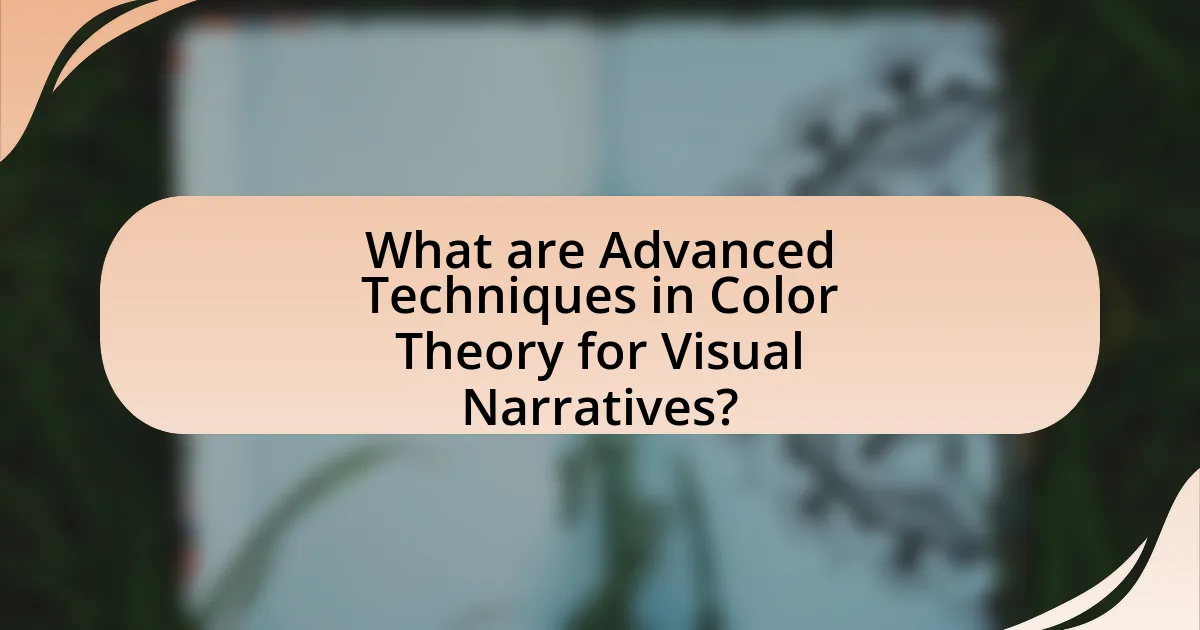
What are Advanced Techniques in Color Theory for Visual Narratives?
Advanced techniques in color theory for visual narratives include the use of color harmony, contrast, and emotional resonance to enhance storytelling. Color harmony involves the strategic combination of colors that are aesthetically pleasing and can evoke specific emotions, such as using analogous colors to create a sense of calm or complementary colors to generate tension. Contrast, particularly in value and saturation, can guide the viewer’s attention and highlight key elements within a narrative, making them more impactful. Emotional resonance is achieved by understanding color psychology; for instance, red can signify passion or danger, while blue often conveys tranquility or sadness. These techniques are supported by studies in visual perception, which demonstrate that color significantly influences viewer interpretation and emotional response, thereby enhancing the overall effectiveness of visual narratives.
How can you use color symbolism to deepen your narrative?
Color symbolism can deepen your narrative by conveying emotions, themes, and character traits through specific colors. For instance, red often symbolizes passion or danger, while blue can represent calmness or sadness. By strategically incorporating these colors into your visuals, you can enhance the emotional resonance of your story. Research in color psychology indicates that colors can influence perception and mood, supporting the idea that color choices can significantly impact audience engagement and interpretation.
What are some examples of color symbolism in popular media?
Color symbolism in popular media includes the use of red to signify passion or danger, as seen in films like “The Sixth Sense,” where red objects indicate the presence of ghosts. Blue often represents calmness or sadness, exemplified in “Avatar,” where the blue Na’vi symbolize harmony with nature. Green is frequently associated with envy or growth, as illustrated in “The Great Gatsby,” where the green light represents unattainable dreams. Yellow can signify happiness or caution, evident in “The Simpsons,” where the bright yellow characters convey a sense of humor and absurdity. These examples demonstrate how color choices in media effectively communicate themes and emotions to the audience.
How can cultural differences in color perception affect your narrative?
Cultural differences in color perception can significantly affect your narrative by influencing how audiences interpret emotions, themes, and symbolism associated with colors. For instance, while white is often associated with purity and weddings in Western cultures, it symbolizes mourning and funerals in many Eastern cultures. This divergence can lead to misinterpretations of a narrative’s intent or emotional tone if the color choices do not align with the cultural context of the audience. Research by Aslam (2006) in the “Journal of Fashion Marketing and Management” highlights that color meanings vary widely across cultures, emphasizing the importance of understanding these differences to effectively communicate through visual narratives.
What role does color grading play in visual storytelling?
Color grading plays a crucial role in visual storytelling by enhancing the emotional tone and atmosphere of a narrative. It allows filmmakers and visual artists to manipulate colors to evoke specific feelings, establish mood, and guide audience perception. For instance, warm tones can create a sense of comfort or nostalgia, while cooler tones may evoke feelings of sadness or detachment. Research indicates that color can influence viewer emotions and interpretations, as demonstrated in studies like “The Impact of Color on Marketing” by Satyendra Singh, which highlights how color affects consumer behavior and emotional responses. Thus, effective color grading is essential for conveying the intended message and enhancing the overall storytelling experience.
How can color grading enhance the emotional impact of a scene?
Color grading enhances the emotional impact of a scene by manipulating hues, saturation, and contrast to evoke specific feelings. For instance, warm tones like reds and oranges can create a sense of warmth or passion, while cooler tones such as blues and greens can evoke calmness or sadness. Research indicates that color influences mood and perception; a study published in the journal “Color Research and Application” by researchers from the University of California found that colors can significantly affect emotional responses, with participants associating certain colors with specific feelings. Therefore, effective color grading can guide audience emotions and deepen their connection to the narrative.
What software tools are available for color grading?
Software tools available for color grading include DaVinci Resolve, Adobe Premiere Pro, Final Cut Pro, Avid Media Composer, and Filmora. DaVinci Resolve is widely recognized for its advanced color correction capabilities and is used in professional film production. Adobe Premiere Pro offers integrated color grading tools that are user-friendly for video editors. Final Cut Pro provides a range of color grading features tailored for Mac users. Avid Media Composer is favored in the television and film industry for its robust editing and color grading options. Filmora is a more accessible option for beginners, offering basic color grading tools. These tools are essential for enhancing visual narratives through effective color theory application.
What are best practices for using color theory in visual narratives?
Best practices for using color theory in visual narratives include understanding color harmony, utilizing contrast effectively, and considering cultural associations of colors. Color harmony, achieved through complementary, analogous, or triadic color schemes, creates visual balance and enhances storytelling. Effective contrast, such as using light and dark colors, helps to emphasize key elements and guide viewer attention. Additionally, cultural associations, like red symbolizing passion in Western cultures and luck in Eastern cultures, inform emotional responses and deepen narrative impact. These practices are supported by studies in visual perception, which show that color significantly influences audience engagement and interpretation.
How can you test color choices with your audience?
To test color choices with your audience, conduct A/B testing by presenting different color schemes to segments of your audience and measuring their responses. This method allows you to gather quantitative data on preferences and engagement levels associated with each color choice. For example, a study by HubSpot found that A/B testing can improve conversion rates by up to 300%, demonstrating the effectiveness of this approach in understanding audience preferences. Additionally, surveys and focus groups can provide qualitative insights into emotional reactions to specific colors, further informing your design decisions.
What tips can help you maintain consistency in color usage?
To maintain consistency in color usage, establish a defined color palette that includes primary, secondary, and accent colors. This approach ensures that all visual elements adhere to a cohesive scheme, which enhances brand recognition and visual harmony. Research indicates that consistent color usage can increase brand recognition by up to 80%, demonstrating the importance of a well-defined palette in visual narratives. Additionally, utilizing tools like color wheels and digital design software can help in selecting and applying colors consistently across various platforms and materials.
